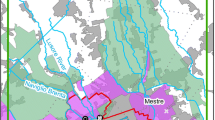Abstract
One of the most significant water resources in the Republic of Croatia is the catchment area of the Kupa River, located in the region bordering the Republic of Slovenia. About 88% of the total amount of water in this catchment originates in Croatia and just 12% from Slovenia; therefore, the largest part of the catchment area (about 1000 km2) is on the Croatian side of the border. It is a typical karst area of the Dinarides with aquifers characterized by a relatively rapid water exchange, high groundwater flow velocities and aquifers open to human impact from the surface. Consequently, the aquifers are highly vulnerable and at risk. Due to the availability of large quantities of high-quality spring water (about 6 m3/s), the entire area has a strategic importance within the context of any future development strategy pertaining to the western part of Croatia. The catchment area on the Croatian side was investigated using a wide range of research methods that included a classical hydrogeological approach, the detailed hydrologic calculation of water balance to the hydrogeochemical analyses and modelling. The objective was to determine protection zones and protection measures for the whole area. The difficulties are increased due to the fact that the karst catchment area is crossed by major traffic corridors, oil pipelines and a railway and that many settlements and a highly developed wood industry are present. The combination of protecting water resources with adequate prevention measures and necessary remedial activities that should satisfy the very strict requirements necessary for the protection of the karst aquifers while still allowing for present and future human activities is difficult – but not impossible – to achieve. One good example is the present highway with a closed dewatering system and waste water treatment before the water passes into the karst underground system.











Similar content being viewed by others

References
Biondić B, Pavičić A (1998) The use and protection of the strategic resources of potable water from the Dinaric karst aquifers of Croatia. In: Brahana JV, Eckstein Y, Ongley LK, Schneider R, Moor JE (eds) Proc IAH Symp gambling Groundwater. American Institute of Hydrology, Las Vegas, pp 645–653
Biondić B, Biondić R, Dukarić F (1998) Protection of karst aquifers in Dinarides in Croatia. Environ Geol 34:309–319
Foetterle F (1855) Geologische untersuchung des Kroatischen küstenlandes. Jahrb Geol R. A. Bd. VI, Vienna
Hauer F (1868a) Geologische ubersichteskarte den Österreichischen Monarchie. Blatt VI Ostl. Aplpenländer, 1:576.000, Vienna
Hauer F (1868b) Erläuterungen zur geologischen ubersichtskarte der Österreichischen Monarchie. Blatt X, Dalmatien. Jahrb. der. geol. R. A. 18, Vienna
Herak M (1957) Geology and hydrogeology of Kupa River region from spring zone to Ozalj. Technical report, Institute of Geology, Zagreb
Herak M (1962) Tectonic nase of hydrogeologic relations in discharge areas of Kupa and Korana. In: Proc 5th Conf Geologist. Belgrade
Herak M (1980) The Nappe-system between Vrbovsko and Delnice in Gorski kotar (Croatia). Acta Geol 10/2, Prirod. istr., JAZU, pp 35–51, Zagreb
Herak M (1986) A new concept of geotectonics of the Dinarides. Acta Geol 16/1, Prirod. istr. 53, JAZU, pp 1–42, Zagreb
Herak M (1994) Dinarides – mobilistic view on geneses and structures. Acta Geol 21/2, Prirod. istr. 63, JAZU, pp 35–117, Zagreb
Kapelj S, Biondić B, Marković T, Biondić R (2002) Hydrochemical and isotope study of the upper part of the Kupa River drainage area – Croatia. Berichte des Institutes fur Geologie und Palaeontologie der Karl-Franzens-Universitaet Graz, pp 15–17
Koch F (1931) Geologic map Delnice-Sušak, scale 1:75.000. Geol. Inst. K. Jugoslavije, Belgrade
Kormoš T (1890) Geological map of ‘Lase-Čabar’ region, scale 1:75.000, Vienna
Lipold MV (1858) Manuscript geological map Lož-Čabar, scale 1:75.000, Vienna
Salopek M (1914) Bericht über die geologische aufname in Gorski kotar. Jahreb. Der R. A., Budapest
Salopek M (1949) Upper Paleozoic of Mrzle Vodice region in Gorski kotar. Ljetopis JAZU 55, pp 175–185, Zagreb
Savić D, Dozet S (1985) Basic geological map-sheet Delnice, Guidebook, Scale 1:100.000. Federal Geological Institute, Begrade
Schubert F (1912): Geologische führer durch die nordlische Adria. Sammlung geol. führer No. 17, Berlin
Vogl V (1913) Die paläodys von Mrzla Vodica in Kroatien. Mitteil. s. d. Jahrb. d. k. ung. geol. R. A. Br. 23, Budapest
Author information
Authors and Affiliations
Corresponding author
Rights and permissions
About this article
Cite this article
Biondić, B., Biondić, R. & Kapelj, S. Karst groundwater protection in the Kupa River catchment area and sustainable development. Environ Geol 49, 828–839 (2006). https://doi.org/10.1007/s00254-006-0178-4
Received:
Accepted:
Published:
Issue Date:
DOI: https://doi.org/10.1007/s00254-006-0178-4



